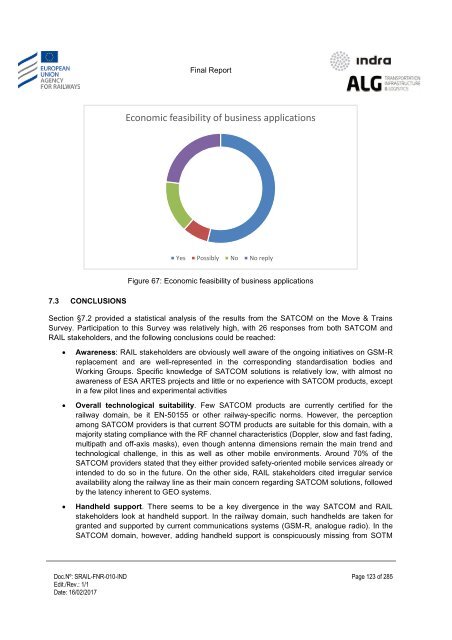Study on feasibility of SATCOM for railway communication
SRAIL-FNR-010-IND%20-%20FinalReport_v1.1_20170216
SRAIL-FNR-010-IND%20-%20FinalReport_v1.1_20170216
You also want an ePaper? Increase the reach of your titles
YUMPU automatically turns print PDFs into web optimized ePapers that Google loves.
Final Report<br />
Ec<strong>on</strong>omic <strong>feasibility</strong> <strong>of</strong> business applicati<strong>on</strong>s<br />
Yes Possibly No No reply<br />
7.3 CONCLUSIONS<br />
Figure 67: Ec<strong>on</strong>omic <strong>feasibility</strong> <strong>of</strong> business applicati<strong>on</strong>s<br />
Secti<strong>on</strong> §7.2 provided a statistical analysis <strong>of</strong> the results from the <strong>SATCOM</strong> <strong>on</strong> the Move & Trains<br />
Survey. Participati<strong>on</strong> to this Survey was relatively high, with 26 resp<strong>on</strong>ses from both <strong>SATCOM</strong> and<br />
RAIL stakeholders, and the following c<strong>on</strong>clusi<strong>on</strong>s could be reached:<br />
<br />
<br />
<br />
Awareness: RAIL stakeholders are obviously well aware <strong>of</strong> the <strong>on</strong>going initiatives <strong>on</strong> GSM-R<br />
replacement and are well-represented in the corresp<strong>on</strong>ding standardisati<strong>on</strong> bodies and<br />
Working Groups. Specific knowledge <strong>of</strong> <strong>SATCOM</strong> soluti<strong>on</strong>s is relatively low, with almost no<br />
awareness <strong>of</strong> ESA ARTES projects and little or no experience with <strong>SATCOM</strong> products, except<br />
in a few pilot lines and experimental activities<br />
Overall technological suitability. Few <strong>SATCOM</strong> products are currently certified <strong>for</strong> the<br />
<strong>railway</strong> domain, be it EN-50155 or other <strong>railway</strong>-specific norms. However, the percepti<strong>on</strong><br />
am<strong>on</strong>g <strong>SATCOM</strong> providers is that current SOTM products are suitable <strong>for</strong> this domain, with a<br />
majority stating compliance with the RF channel characteristics (Doppler, slow and fast fading,<br />
multipath and <strong>of</strong>f-axis masks), even though antenna dimensi<strong>on</strong>s remain the main trend and<br />
technological challenge, in this as well as other mobile envir<strong>on</strong>ments. Around 70% <strong>of</strong> the<br />
<strong>SATCOM</strong> providers stated that they either provided safety-oriented mobile services already or<br />
intended to do so in the future. On the other side, RAIL stakeholders cited irregular service<br />
availability al<strong>on</strong>g the <strong>railway</strong> line as their main c<strong>on</strong>cern regarding <strong>SATCOM</strong> soluti<strong>on</strong>s, followed<br />
by the latency inherent to GEO systems.<br />
Handheld support. There seems to be a key divergence in the way <strong>SATCOM</strong> and RAIL<br />
stakeholders look at handheld support. In the <strong>railway</strong> domain, such handhelds are taken <strong>for</strong><br />
granted and supported by current communicati<strong>on</strong>s systems (GSM-R, analogue radio). In the<br />
<strong>SATCOM</strong> domain, however, adding handheld support is c<strong>on</strong>spicuously missing from SOTM<br />
Doc.Nº: SRAIL-FNR-010-IND<br />
Edit./Rev.: 1/1<br />
Date: 16/02/2017<br />
Page 123 <strong>of</strong> 285


